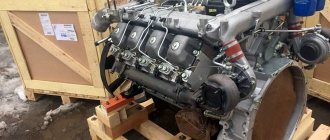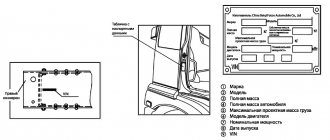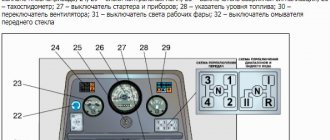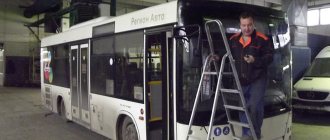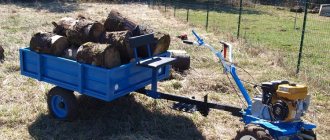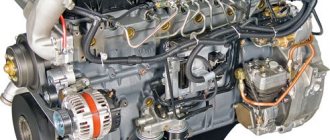The TS 350 self-propelled trolley, popularly nicknamed the “Lunokhod” for its wheelbase of six wheels, appeared in the vastness of the Soviet Union in 1989 at the Motor Plant in Tyumen. Since at that time there was no special choice of household agricultural equipment, the TC 350 took its place in this class and greatly facilitated the work of people both in agriculture and in production.
The peculiarity of the self-propelled trolley is that it uses the principle of a caterpillar tractor. Although it has a wheelbase. Therefore, the TC 350 does not require much space for turning and maneuvering.
Self-propelled trolley TS 350
Technical characteristics of TC 350
| Characteristics | Unit of measurement | Indicators |
| Type | type | wheeled all-wheel drive, tracked (homemade) |
| Length | mm | 2230 |
| Width | mm | 1390 |
| Height | mm | 1320 |
| Clearance | mm | 350 |
| Body volume | m.cub. | 0,4 |
| Weight of equipment | kg | 500 |
| Load capacity | kg | 350 |
| Power point | type | 1-cylinder, petrol, UMZ-5B |
| Power | hp | 5 |
| Speed | km/h | up to 30 |
| Fuel consumption | g/h | 1425 |
| Fuel | A | 76, 80 |
| checkpoint | type | fur, 2 pcs. |
| Gearbox drive | type | belt |
| Number of gears | PC. | 4-forward, 2-backward |
| Wheel drive | type | chain |
Electric version of a self-propelled trolley
Often, households simply need a wheelbarrow with a drive to move soil, fertilizer or construction waste 10-30 m. In this case, there is no need to build a serious device with a gasoline engine; you can completely get by with the electric version, as in the video
According to the author's idea, a gear or belt drive and a high-speed motor from a powerful electric drill or hammer drill are attached to the axle of the wheels of an ordinary garden wheelbarrow. Taking into account the downshift number, the torque of the drill engine is quite enough to push a loaded wheelbarrow at walking speed.
To power the electric motor, you will need to stretch additional wiring and hang it on a tensioned wire along the route of movement. To make the work easier for the wheelbarrow, you will need to lay a hard covering of boards or slabs, otherwise after 10-15 minutes of operation the engine of the cart will overheat and fail.
Purpose of the TS 350 “Lunokhod” trolley
The success of the TC 350 self-propelled trolley is ensured not only by its small dimensions and the ability to turn around on the spot, but also by its versatility. At one time, a huge selection of replaceable working equipment was developed for the TS 350 self-propelled trolley - mechanical and hydromechanical, earthmoving, lifting, harvesting, for concrete work, for agriculture, etc. Nowadays, it is almost impossible to find and purchase factory-made attachments, but thanks to the simplicity of the TC 350 design, the necessary equipment can be made with your own hands, having the necessary material, direct hands and enthusiasm.
Industrial self-propelled trolleys
If you set a goal and find a suitable self-propelled vehicle, you will be offered either a hydraulic self-propelled trolley - loader, or a Chinese version of a mini-dumper on caterpillar tracks. For work in the field or at the construction site of a large facility, such a mini-tractor with a lifting capacity of 300 kg may be suitable, but there are few people willing to pay 2 thousand dollars for the opportunity to transfer cargo at a snail’s pace.
Self-propelled vehicles from Honda will be very interesting for households. Its mini-dumpers can hardly be called a self-propelled trolley; they are more construction equipment, but in a private home a small device would be very useful.
For example, the ANTBY800 model is equipped with a 13 hp gasoline engine. Essentially, this is a hydraulic self-propelled cart, since it is based on a hydraulic drive that distributes torque to orbital engines. The trolley is capable of moving up to 800 kg of cargo in the cargo compartment, lifting up to 300 kg to a height of 1.4 m and transporting a trailer weighing up to 2 tons. The hydraulic circuit made it possible to equip the minitractor with a working shovel-blade like a bulldozer. But, like the Lunokhod, Honda’s miracle does not have a cabin or even a place for the operator, which is not entirely convenient, especially if you have to work on the trolley for quite a long time. The cost of a self-propelled cart is almost 700 thousand rubles.
Lighter self-propelled carts, as in the video
They are an order of magnitude cheaper, but in terms of their capabilities they are of little use for housework. As a rule, self-propelled designs have a high center of gravity, a weak engine and a short wheelbase. It is convenient to transport loads up to 50 kg over relatively short distances. For construction work or transportation of materials, the engine is clearly not enough.
All that remains is to make a self-propelled vehicle with your own hands:
- Adapt existing transport equipment with an engine, for example, a snow blower, walk-behind tractor or walk-behind mower, to a self-propelled cart;
- Assemble an original self-propelled structure based on a chainsaw engine and a homemade welded frame;
- Modify an old scooter, use the engine and transmission;
- Assemble an electric self-propelled cart.
All of the listed options have long been tried by craftsmen in practice, and many of the assembled homemade carts have shown good results. The main advantage of making a self-propelled cart with your own hands is the ability to customize the design to your needs. In addition, building a self-propelled carrier from spare parts and components will cost much less than a purchased cart.
Design of TC 350
The design of the TS 350 self-propelled trolley consists of a platform, which is an all-welded rigid structure onto which all the units and components of the trolley are mounted. In the tunnels of the platform there is a chain drive to drive the wheels; hubs with wheels are attached to the sides of the platform from the outside. A tilting body is hinged at the front of the platform; the power unit is mounted on a removable beam to the left of the driver.
The transmission of the TS 350 self-propelled trolley consists of two gearboxes. Each box is responsible for driving the wheels on one side of the cart. The drive from the power plant to the gearboxes is carried out via two V-belts. A double-groove pulley is installed on the crankshaft, which is equipped with two belts. Each of them is responsible for transmitting torque to its own box.
The drive shafts of the gearboxes are equipped with brake band brake mechanisms, which are controlled by two levers, similar to a caterpillar tractor. But it is better to use these mechanisms when adjusting the direction of movement. That is, if it is necessary to make a small turn, the driver pulls the lever, which slows down the rotation of the gearbox drive shaft, while the second gearbox continues to operate without slowing down at this time. Each gearbox has 4 forward speeds and 2 reverse speeds. Here, changing gears separately on each box makes it possible to completely turn the trolley on the spot.
If you turn on 2nd forward gear on one of the gearboxes, and 2nd reverse on the second, the wheels of the cart will rotate in different directions, but at the same speed, which will ensure it turns on the spot.
The self-propelled trolley is equipped with a standard UMZ-5B engine, which is a four-stroke, single-cylinder, air-cooled internal combustion gasoline engine. The engine has a two-stage gearbox with gear ratios of 1:6 and 1:2.91, changing the speed of the output shaft. Nowadays, many users are switching to Chinese engines of higher power and efficiency, and are also installing starting from a starter.
|
|
|
|
UMZ-5B engine instructions - download / read PDF
Parts for self-propelled vehicle
Top 15 garden and construction two-wheeled wheelbarrows
A self-propelled cart with a practically indestructible transmission can be built with your own hands from a domestic chainsaw such as “Druzhba” or “Ural”. It is clear that domestic equipment is chosen primarily because of the successful layout of the engine design and the relatively low price of the device.
As in the case of a scooter, we do not touch the chainsaw engine; only the clutch assembly and the cutting chain drive sprocket need to be slightly altered. First of all, you will need to completely remove the clutch from the engine. The silumin engine crankcase is cut so that a window 30 mm wide and 70 mm long is obtained in the lower part. The window dimensions are preliminary and can be adjusted during the manufacturing process of the self-propelled trolley. An example of how the crankcase is rebuilt can be seen in the video
The transmission of a self-propelled trolley is made in the form of a chain drive. You can use a single-row chain from a light motorcycle or a double-row from a car engine. It all depends on what spare parts the master has at his disposal and what load is planned on the self-propelled cart. In addition, you will need to select the ratio of the teeth of the drive sprocket and the gear. Usually, a ready-made chain drive from an old motorcycle like “Java”, “Izh” or “Minsk” is perfect for a self-propelled trolley.
To choose the right chain drive, you need to compare the speed of a motorcycle engine in first gear and the average speed of a chainsaw. Only in this case can you count on obtaining an acceptable speed of the self-propelled trolley. The speed in first gear is 5-9 km/h, but since the chainsaw engine speed is significantly higher, the cart can reach speeds of up to 20 km/h and higher.
In the design of the chainsaw, there is no shaft or boss on the clutch housing on which the driven sprocket can be installed. You have to disassemble the assembly and weld a finished shaft, taken from a motorcycle engine or made independently.
This is the most difficult part of the work, since you will need to turn the seating shoulder onto the disk on a lathe. Any attempts to weld the shaft to the disc “on the knee” can damage the entire engine; the more accurately the shaft is welded, the less vibration there will be on the frame of the self-propelled cart when the chainsaw motor is running. To prevent the car body from sweating oil stains, you will need to install a new oil seal or packing seal.
Spare parts for TS 350 and their analogues
| TS 350 wheels | Original tires - size 5.00 - 10 model 8-19ADims bolt pattern 4x120. suitable for wheels with a bolt pattern of 4x114.3 with minor modification using a file |
| Hub TS 350 | Cone bearing 6-7805U (front hub VAZ 2101) Oil seal 30x57x10 (I couldn’t find the original size, I bought a VAZ gearbox secondary shaft oil seal size 32x56x10) Axle shafts made of 30KhGSA steel with heat treatment F25 shafts, made of heat-treated steel. Splines like the input shaft of the M-412 box |
| Chain TC 350 | PR-19.05-31.8 is about 3.5 meters long per side. |
| Belts TS 350 | Profile B(V)-1250, recommended analogue of Powerated 6949. Profile dimensions: top 17mm, wall 11mm. |
| Gearbox TS 350 | LITOL lubricant 700 grams + 70 grams of transmission oil, in each gearbox Bearings: 180206 - 3 pcs. (Bearing for suspended propeller shaft for Gazelle car) 6204(180204)-4 pcs. 6204(180204) - 2 pcs. - In the idler gear. |
| Parasitic chain stars TC 3550 | 6204(180204)-6 pcs. — In parasitic stars |
An alternative option, or a self-propelled cart based on home motorized equipment
The easiest way to build a self-propelled cart is to repurpose household appliances used for cleaning the yard, shoveling snow or mowing grass. The best option for building a self-propelled vehicle would be to re-equip equipment that sits uselessly in a garage or shed during the warm season. This is a manual self-propelled snow blower with a gasoline engine.
The snow removal machine has all the necessary components - an engine, rear wheel drive and a manual control system. To convert a snow blower into a self-propelled cart version, you will need to perform the following operations. Initially, it is necessary to dismantle the shovel or auger snow pick-up. As a rule, auxiliary units are installed on the front frame beam. The driven shaft and belt drive pulley for the engine power take-off are also installed there.
Instead of the standard frame, you will need to weld a new frame structure designed for increased load. If the snow blower has a 3-4 hp engine, then you will need a frame made of profiled pipe with a cross-section of 20x40 mm and a wall thickness of at least 2 mm.
The frame will need to be made with an increased size of the base, since the cargo box will rest on the front beam of the structure, and brackets will need to be installed in the lower part for installing the rotary axles of the wheels.
For a self-propelled trolley, it is important to ensure easy turning and maneuvering in a limited area. For the front wheels, it is best to use self-aligning independent wheels with rubber running
The location for installing the box is selected in such a way that the weight from the engine and cargo is evenly distributed over all four wheels. Rotary hinges are installed on the front beam of the frame; you can use garage awnings; any others, even door ones, will be too weak and will not last long. The cargo compartment will rotate on the canopies and unload bulk materials with a dump truck, as in the video
To prevent the cargo box from jumping when moving, it will be necessary to provide a lock - a latch. The shape of the box can be chosen in any order, it is best to copy the standard diagram of a garden wheelbarrow, the main thing is to choose the right dimensions of the cargo compartment. For a self-propelled vehicle, the optimal volume would be 40-50 liters. If the self-propelled cart will not be used for transporting humus, manure or organic fertilizers, then the cargo compartment can be made of plywood, and the joints and seams can be reinforced with steel angle or simply covered with galvanized metal.
Most often, they try to use a conventional walk-behind tractor with a gasoline engine to make a self-propelled cart. Most craftsmen note that converting any walk-behind tractor into a self-propelled vehicle is not a very good idea, since the unit costs quite a lot of money, has only one pair of wheels and a high engine installation. As a result of alterations, such a cart will cost a lot of money, and the end result is a long and unstable vehicle that is difficult to control on the road.
Self-propelled trolley TS 350 and its analogues
After the collapse of the Soviet Union, the production of TS 350 was carried out by OJSC Gazturboservice until 2015. At present, production has stopped, but it was sold throughout the country in quite large quantities. You can now buy a used cart for 5,000 rubles, but its condition will, of course, be so-so. The average price for a TS-350 in normal technical condition ranges from 35 to 45 thousand rubles. Spare parts for it can be found at any auto store, because... it was originally created on the basis of existing technology. The Fedor ShUS-minitractor is also produced, which is structurally similar to the TS 350.
How do you like the article?
Description of the self-propelled trolley
Blower calm
The self-propelled trolley TS 350 was a small loading platform on wheels with a gasoline engine. This low-power device has been designed for transport work and can also be used for cultivating soil in the garden. The design of this unit is interesting in that it is based on the principle of a caterpillar tractor, despite the fact that only wheeled models were produced.
The main purpose of the TC 350 is to transport cargo weighing up to 350 kg over short distances. It even has a small body that can tip over to dump bulk materials, like a dump truck. It is also possible to use this model for towing plows, harrows and some other tillage implements. In front you can mount a blade for removing snow or construction debris. This makes the TC-350 a universal assistant for the farmer.
The trolley allows you to transfer various loads
Design
The design is quite simple, which ensures high reliability. The vehicle is equipped with six wheels located on the sides. It is noteworthy that all wheels are driven, but there are no steered wheels. Maneuvers are accomplished not by turning away from the steering wheel, but by blocking the rotation of the wheels on one side while the wheels on the other side continue to rotate. This principle of tracked vehicles significantly increases maneuverability. The trolley is capable of making a full rotation on the spot.
The design is based on a steel frame on which all devices are mounted. The manual tilt body is mounted on the front of the frame. A UMZ-5B gasoline engine, taken from a Ural walk-behind tractor, is mounted on the left side of the frame. The transmission is designed in an original way and consists of two gearboxes. Each box controls the wheels on one side of the trolley and has its own motor drive (V-belt). Accordingly, the crankshaft is equipped with a special double pulley, which carries both belts. Each transmits rotation to its own gearbox. The rotation is carried out by a lever, which slows down the corresponding gearbox. At this time, the second box continues to spin the wheels at the same pace, making a turn or turn.
Each gearbox has 4 forward gears and 2 reverse gears. Gear shifting is individual for each box and allows you to rotate the cart around its axis. To do this, you need to engage the second forward gear on one gearbox and the second reverse gear on the other.
The driver's seat is located to the right of the engine. There is no steering wheel, control is carried out by two levers that drive the brake mechanisms of the transmission drive shafts. The seat has the ability to rotate in a circular manner, which allows the cart to be used for moving in different directions and helps to avoid turns.
Reviews
Evgeniy (Vladikavkaz) I bought it a long time ago, I’ve been using it for 15 years, no problems have arisen. In a subsidiary farm, equipment is simply irreplaceable.
Sergey (Samara) I purchased it in the late 90s with various attachments, but I mainly use it for transporting goods and plowing the garden.
Also interesting: Tuning NIVA/UAZ headlights - CRILINE
Konstantin (Novosibirsk) I bought it a long time ago, there were problems with the chains, I installed stronger chains with a pitch of 19.05, so now there are no problems, but in case of overload they slip and therefore the sprockets, hubs and gears are damaged. But I don't allow this. Today, drawings of the TS 350 are freely available, so everything can be fixed.
Read news about the new Niva
- Niva Pickup VAZ-2329 lada 4×4 – review
- Niva Chevrolet air conditioning installation - Online auto workshop
- Do-it-yourself Niva 2121 elevator: drawings, dimensions
- How to change oil in VAZ Niva axles
- Boarding house with treatment "Niva", Anapa
- Test drives and reviews of ZX Grand Tiger (ZongHing Grand Tiger). The tiger is coming!
- Do-it-yourself replacement of Niva Chevrolet silent blocks: upper hinges of the front arms, rubber or polyurethane?
- Niva tuning: 145 photos of ideas on how to improve the VAZ 2121 with your own hands
Self-propelled scooter trolley
Most often, old scooters and bikes become donors of parts and spare parts. After the introduction of mandatory registration of mini scooters and mopeds, many owners began to look for where to use the old engine. Japanese scooters typically have a very durable high-revving gasoline engine with an oil clutch and a semi-automatic transmission.
Nowadays, original Honda scooters are almost universally replaced by Chinese self-propelled vehicles. Chinese scooters can break down on the second day of use, but there are some that work no worse than the Japanese. This is exactly the kind of equipment you need to look for during disassembly.
A self-propelled trolley is made from a scooter in the following order:
- Initially, the rear part of the frame with the engine, automatic transmission and wheel is cut off with a grinder, the tank, engine and brake controls are dismantled;
- If the self-propelled trolley is assembled according to the tricycle design, then for the cargo compartment you will need to select a wheel pair with an axle and an axle, as in the photo;
- The rear suspension must be further strengthened with a U-shaped frame made from an angle or profile pipe. A wheel platform for the driver will be attached to the frame;
- The transition from the cargo part to the rear suspension is made in the form of a Y-shaped two-handed beam; clutch and engine throttle controls are installed on the handles.
The trolley's transmission and engine remain untouched; no one has yet been able to convert the miracle of Japanese technology into something more advanced at home.
Advice! Therefore, even if you come across projects with a radical modification of the engine or belt variator, bypass them on the tenth road. It is best to use the native engine layout for a self-propelled cart.
The operator controls the self-propelled cart while standing on the rear folding wheeled platform. Similar schemes are widely used in the designs of heavy one and a half liter walk-behind tractors produced by the Chinese for the countries of Southeast Asia. The design has proven to be extremely convenient and practical; moreover, a self-propelled trolley with this arrangement is much more stable and controllable than “lazy” designs in which the driver sits above the engine, or like on a walk-behind tractor with a trailer.
How convenient it is to operate a self-propelled trolley while standing on the platform can be judged from the video
One thing can be said - even with an empty cargo compartment, you can ride a self-propelled trolley much faster and safer than a walk-behind tractor.
Ways to improve cross-country ability
Increasing the maneuverability of a self-propelled device is one of the key tasks of all owners. To achieve the goal, many types of devices are used. One of the most effective is the installation of caterpillar tracks. The TS-350 trolley itself remains unchanged, and accordingly most of the parameters are preserved. The work is carried out in several stages:
- A rubber band is used, the length of which will allow it to cover three wheels. Metal strips are attached to the inside.
- The slats are given a curved shape in order to create a guide for the tape and prevent it from being removed from the wheels.
- Other strips are attached to the outside, acting as lugs.
Methods for increasing cross-country ability
It should be noted that the manufacturer produced only wheeled versions of the carts. However, to increase the maneuverability of this device, various devices are used, including the use of caterpillar tracks.
Craftsmen simply take a rubber band with a length that allows them to completely cover all three wheels in a circle. On the inside of the tape, metal strips with bends are attached to it. These bends form a guide for the belt, which prevents it from being removed from the wheels. On the outside, metal strips are also attached, which act as lugs. The wheels of the trolley are both driving and supporting for the belt. In general, it is not so difficult to make a tracked one from a wheeled unit, but while gaining in cross-country ability, the TS-350 loses speed indicators, which are not so high.
Upgraded mini all-terrain vehicle TS-350: photo and description
The TS-350 self-propelled all-terrain vehicle is designed for transporting small loads in off-road conditions and has high maneuverability in snow and mud.
The TS-350 self-propelled trolley was produced in the 90s, in the city of Tyumen. Despite the fact that this vehicle has proven itself well, the TS-350 trolley is no longer produced.
The TS-350 mini all-terrain vehicle has small dimensions and is highly maneuverable; it can be deployed almost on the spot. In addition, the all-terrain vehicle has an independent transmission, which made it possible to install a separate drive for each wheel. Driving this vehicle is so easy that no special driving skills are required.
The owner of this TS-350 improved the design, in particular, installed a more powerful UD-25 engine, 2 cylinders, 12 hp, instead of the standard 6 hp engine.
Electric ignition is also installed, and a mounting frame for a standard car battery is provided on the starboard side.
The trolley control system has been significantly changed. The drive pulleys are connected to the motor via a variator. At minimum gas, the variator loosens the tension of the drive belt, the cart does not move. The gas regulator is located on the control lever. As the gas increases, the variator tightens the belt and the cart moves straight.
To turn, you need to pull the left/right control lever towards you. It weakens the drive tension of the left/right row of wheels, they lock, and a turn occurs. Compared to the standard layout, this control is much more convenient - you don’t have to hold the levers towards yourself all the time - it gets very boring if you need to drive for more than a couple of minutes.
The gearboxes are left standard: 2 forward / 1 reverse.
Overall dimensions of the mini all-terrain vehicle: L x W x H: 2230x1390x1320 mm. Trolley weight: 500 kg. Maximum speed is about 30 km/h.
We also suggest watching a short video review of the all-terrain cart.
(2 ratings, average: 4.50 out of 5)
sam-stroitel.com
Purpose
The main purpose of the TS 350 self-propelled trolley is to transport cargo weighing up to 350 kg over short distances. For this purpose, the trolley is equipped with a small body with the ability to tip over. It is also possible to use this device to perform some agricultural work, for which the cart has a towing device for some soil-cultivating implements, and a dump bucket can be attached to the front of this cart. In general, the TS-350 trolley is a fairly universal assistant, since it can be used in different areas.
Design of self-propelled special equipment
The TS-350 self-propelled trolley is informally called a “mini-tractor”. Despite the obvious wheeled design, it uses the tractor crawler principle. There are no steerable wheels in the cart; all are driven. The transmission consists of two gearboxes responsible for driving the wheels on each side. They are connected to the power unit by two V-belts.
There are six speeds in total: four forward and two reverse. The drive shafts are equipped with belt-type brake mechanisms, which are controlled by two levers. The entire trolley is an all-welded metal platform on which all the necessary components and the engine are located. There is no battery here, so preparations take a minimum of time.
The design of the TS-350 trolley also includes a body with a manual tilting system. The rotation angle of the driver's seat is 90 degrees. The seat is located to the right of the motor and levers that control the brake mechanisms. Thanks to its reliable design, the equipment has high maneuverability, which allows it to be used in any weather.
